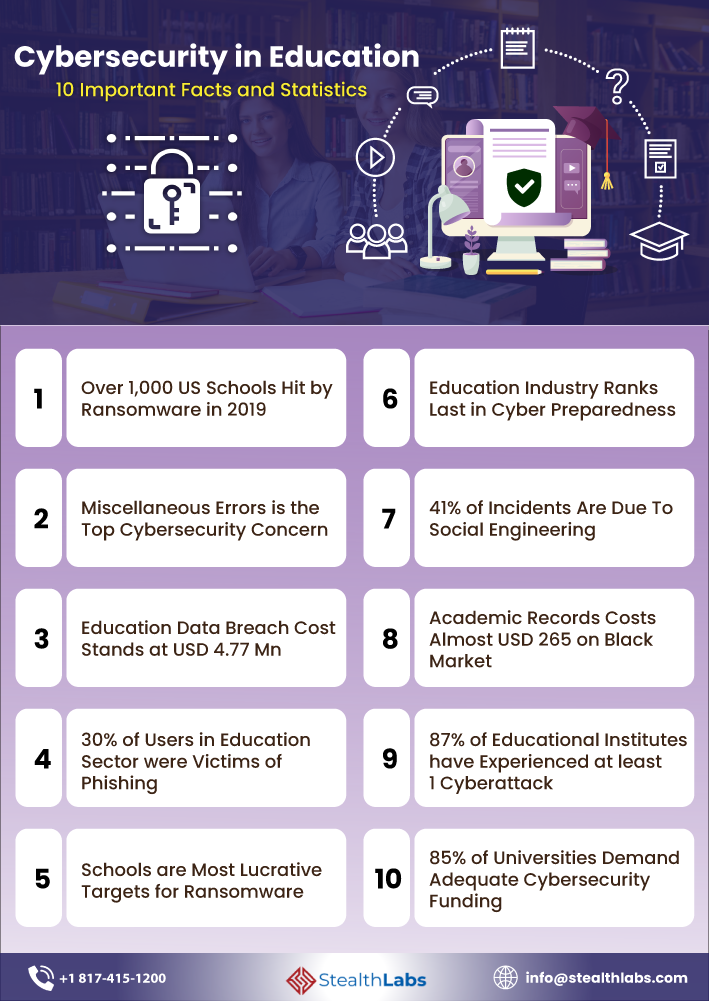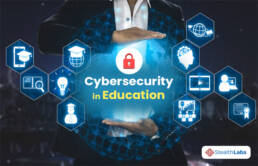As the education sector continues to make progress on its digital transformation journey, schools, colleges, and universities are becoming lucrative targets for cyberattacks.
From ransomware attacks to data breaches, numerous academic institutions have fallen victim to cyberattacks in recent years.
The sudden shift to remote learning triggered by the pandemic has further deteriorated the situation. With students increasingly using their personal computers and unsecured networks to join online classes, the threat vector of the education sector is proliferating.
In fact, in the last month, education was the most affected industry, encountering almost 64% of all malware attacks, or more than 6.2 million incidents, according to Microsoft Security Intelligence.
As the academic realm is expected to operate in crisis mode for an extended period, it’s high time for the education leaders to prioritize cybersecurity and steer their organizations through the trails ahead.
Here are some alarming statistics that underline the dismal state of cybersecurity in the education arena and the need for institutions to build cyber resilience:

1) Over 1,000 US Schools Hit by Ransomware in 2019
In 2019, over 1,000 public schools in the US were hit by ransomware, according to cybersecurity firm Armor. Among the affected schools, Rockville Center School District paid a ransom of USD 88,000 to receive a decryption code for ransomware-encrypted files.
2) Miscellaneous Errors is the Top Cybersecurity Concern
The 2019 Verizon Data Breach Investigation Report (DBIR) revealed that “miscellaneous errors” was the top cybersecurity concern in the academic sector, accounting for almost 35% of all data breaches.
3) Education Data Breach Cost Stands at USD 4.77 Mn
The global average cost of a data breach in the education sector is USD 4.77 million per incident, according to IBM’s Cost of a Data Breach Report. Meanwhile, the undesired average cost per compromised record at the US education institutes is USD 142.
4) 30% of Users in the Education Sector were Victims of Phishing
Though phishing scams are easy to avoid, surveys have shown that a substantial majority of businesses become victims of these attacks every year. The education sector is one of the most vulnerable.
In 2019, 30% of users in the education industry have fallen victim to phishing emails, disguised as a corporate communique, 2x times the rate of the general population.
Also Read: Cyber Security Solutions for Education and Research Institutions
5) Schools are Most Lucrative Targets for Ransomware
Ransomware attacks have increased by 7x times in 2020, compared to 2019. The K-12 education segment is a hotbed for ransomware, accounting for the majority of all ransomware attacks.
According to the FBI’s report, 57% of all reported ransomware attacks in August and September 2020 were targeted at the US K–12 schools, up from 28% for the period from January through July. The average ransom was around USD 50,000, but the highest has crossed USD 1.4 million.
6) Education Industry Ranks Last in Cyber Preparedness
Out of 17 industries surveyed, the education sector ranked last in terms of cybersecurity preparedness, with the highest security vulnerabilities present in application security, endpoint security, and software update.
7) 41% of Incidents Are Due To Social Engineering
Higher education institutions are confronted with an increasingly vulnerable cyber landscape with the rise in social engineering. Around 41% of higher education cyber incidents and breaches were caused by social engineering machinations.
8) Academic Records Costs Almost USD 265 on Black Market
According to the Ponemon Institute, the price at which hackers sell educational records on the black market increased from USD 245 in 2017 to USD 265 in 2018.
9) 87% of Educational Institutes have Experienced at least 1 Cyberattack
A recent VMware survey reveals that more than one-third of UK universities were hit by a successful cyberattack every hour, and 87% have already experienced at least one successful cyberattack.
10) 85% of Universities Demand Adequate Cybersecurity Funding
According to a recent VMware survey, 85% of UK universities demand an increase in cybersecurity funding and investments to protect critical research information and intellectual property. Meanwhile, 64% don’t believe their existing IT infrastructure is sufficient in protecting against cyberattacks.
Conclusion
The aforementioned cybersecurity statistics emphasize the severity of financial and reputational damage the cyberattacks can inflict on education institutions. The repercussions can be unprecedented, especially during the times of pandemic when these institutions can least afford losses.
Education leaders must act now to help prevent breaches. Partnering with Cyber Security Service Providers like StealthLabs can help you develop a robust cybersecurity strategy.
More Articles:

